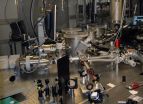(Press-News.org) Chicago (13 May, 2015)- In the latest issue of the Bulletin of Atomic Scientists, published by SAGE, experts from the United States, Russia, and China present global perspectives on ambitious nuclear modernization programs that the world's nuclear-armed countries have begun.
In the latest edition of the Bulletin's Global Forum, Georgetown University professor Matthew Kroenig argues that:
"Failure to modernize would not contribute to disarmament - but more than that, it would be irresponsible. A crippled US nuclear force would embolden enemies, frighten allies, generate international instability, and undermine US national security. In other words, it would risk ruining the world that currently exists. Rather than preparing for an alternate reality, therefore, Washington needs to build the nuclear forces that it needs to deter threats to international peace and security in this reality. This means maintaining a robust nuclear posture and fully modernizing nuclear forces, as planned."
Eugene Miasnikov, director of the Center for Arms Control, Energy and Environmental Studies in Dolgoprudny, Russia, comments that:
"The real question regarding modernization is how much is enough. Which sorts of modernization would create obstacles to further cuts? Which would be neutral? ... It is up to the American people to decide on the future size of their nuclear arsenal and how much modernization is required. But it is important to bear in mind that these decisions will have profound effects on the rest of the world. These decisions might reduce international tensions, which would be conductive to further nuclear cuts. Or they might become a source of additional tension and trust."
And Lu Yin a colonel in China's People's Liberation Army and a researcher at the Institute for Strategic Studies at National Defense University in Beijing, writes that:
"Eliminating nuclear weapons does not appear feasible at this stage. Modernizations of nuclear arsenals are certain to go forward. But it's possible, and very important, to achieve a balance between modernization and disarmament. The United States and Russia must take the lead in establishing this balance - first by de-emphasizing nuclear weapons in their national security strategies so that the practical reasons for possessing nuclear weapons can gradually disappear, and second by reducing their arsenals. This would establish trust and set a good example for other nations."
INFORMATION:
Click the links below to access the full articles:
Matthew Kroenig, How best to approach nuclear modernization?: A US response: http://bos.sagepub.com/content/71/3/16.full.pdf+html
Eugene Miasnikov, How best to approach nuclear modernization?: A Russian response: http://bos.sagepub.com/content/71/3/12.full.pdf+html
Lu Yin, How best to approach nuclear modernization?: A Chinese response: http://bos.sagepub.com/content/71/3/8.full.pdf+html
Bulletin of the Atomic Scientists:
Founded in 1945 by University of Chicago scientists who had helped develop the first atomic weapons in the Manhattan Project, the Bulletin of the Atomic Scientists subsequently created the
Doomsday Clock in 1947 using the imagery of apocalypse (midnight) and the contemporary idiom of nuclear explosion (countdown to zero), to convey threats to humanity and the planet. The decision to move the minute hand of the Doomsday Clock is made by the Bulletin's Science and Security Board in consultation with the Governing Board and the Board of Sponsors, which includes 18 Nobel Laureates. The Clock has become a universally recognized indicator of the world's vulnerability to catastrophe from nuclear weapons, climate change, and emerging technologies in the life sciences.
Bulletin Media Contact: Janice Sinclaire, jsinclaire@thebulletin.org
http://bos.sagepub.com
SAGE Founded 50 years ago by Sara Miller McCune to support the dissemination of usable knowledge and educate a global community, SAGE publishes more than 850 journals and over 800 new books each year, spanning a wide range of subject areas. A growing selection of library products includes archives, data, case studies, conference highlights and video. SAGE remains majority owned by our founder and after her lifetime will become owned by a charitable trust that secures the company's continued independence. Principal offices are located in Los Angeles, London, New Delhi, Singapore, Washington DC and Boston. http://www.sagepub.com
The recombination of electron shells in molecules, taking just a few dozen attoseconds (a billionth of a billionth of a second), can now be viewed "live," thanks to a new method developed by MIPT researchers and their colleagues from Denmark, Japan and Switzerland. An article detailing the results of their study has been published in the journal Nature Communications.
In recent years, scientists have learned how to study ultrafast processes taking place at the atomic and molecular levels, and research in this field is expected to yield some very important results. In ...
This news release is available in German. Chloroplasts are the solar cells of plants and green algae. In a process called photosynthesis, light energy is used to produce biochemical energy and the oxygen we breathe. Thus, photosynthesis is one of the most important biological processes on the planet. A central part of photosynthesis takes place in a specialized structure within chloroplasts, the thylakoid membrane system. Despite its apparent important function, until now it was not clear how this specialized internal membrane system is actually formed. In a collaborative ...
Amsterdam, May 13, 2015 - A new family of molecules that kill cancer cells and protect healthy cells could be used to treat a number of different cancers, including cervical, breast, ovarian and lung cancers. Research published in EBioMedicine shows that as well as targeting and killing cancer cells, the molecules generate a protective effect against toxic chemicals in healthy cells.
Cells can become cancerous when their DNA is damaged. Many different things can cause DNA damage, including smoking, chemicals and radiation; understanding exactly what happens at the point ...
London/Zurich, May 13, 2015: Children in European countries tend to report higher levels of satisfaction with their friendships while children in African countries tend to be happier with their school lives. Children in northern European countries are particularly dissatisfied with their appearance and self-confidence. Most of the 50,000 children in the 15 countries rated their satisfaction with life as a whole (on a scale from zero to ten) positively, but the percentage of children with very high well-being (10 out of 10) varied from around 78% in Turkey and 77% in Romania ...
The time needed to genetically sequence the bacteria causing tuberculosis (Mtb) from patient samples has been reduced from weeks to days using a new technique developed by a UCL-led team. This could help health service providers to better treat disease, control transmission of this infection, and monitor outbreaks.
Tuberculosis (TB) disease rates in some parts of London are as high as in Sub-Saharan Africa, and drug-resistant strains are becoming increasingly common. These require specific treatments, and if doctors know that a bug is resistant they can start therapy ...
A new study published today in the journal Addiction has compiled the best, most up-to-date evidence on addictive disorders globally. It shows that almost 5% of the world's adult population (240 million people) have an alcohol use disorder and more than 20% (1 billion people) smoke tobacco. Getting good data on other drugs such as heroin and cannabis is much more difficult but for comparison the number of people injecting drugs is estimated at around 15 million worldwide.
The "Global Statistics on Addictive Behaviours: 2014 Status Report" goes further in showing that ...
Roughly 1 in 4 women having breast conserving surgery (BCS) return to the surgical suite for further resection because of cancerous tissue left behind due to unclear margins. Investigators at the Optics in Medicine Lab at Dartmouth's Thayer School of Engineering and Norris Cotton Cancer Center, led by Brian W. Pogue, PhD and Keith Paulsen PhD, with first author and PhD candidate David M. McClatchy III, devised a novel approach to perform near infrared (NIR) optical measurements of resected breast tissue after the margins have had their traditional marking by the surgeon ...
(Boston)--Repetitive head injuries that occur during contact sports and military service may accelerate the aging process by increasing the build-up of beta-amyloid in the brain, leading to worse disease and an increased likelihood of developing dementia. In particular, boxers fared the worst among athletes and military veterans with a history of head injuries.
These findings, which currently appear online in the journal Acta Neuropathologica, is the first to establish the age-dependent deposition of beta-amyloid in chronic traumatic encephalopathy (CTE), and may lead ...
URBANA, Ill -- Wetlands created 20 years ago between tile-drained agricultural fields and the Embarras River were recently revisited for a new two-year University of Illinois research project. Results show an overall 62 percent nitrate removal rate and little emission of nitrous oxide, a potent greenhouse gas.
"Slowing down the rate of flow of the water by intercepting it in the wetland is what helps to remove the nitrate," says Mark David, a University of Illinois biogeochemist in the College of Agricultural, Consumer and Environmental Sciences. "The vegetation that ...
The act of identifying a perpetrator does not just involve memory and thinking, but also constitutes a moral decision. This is because, by the act of identifying or not identifying someone, the eyewitness runs the risk of either convicting an innocent person or letting a guilty person go free.
In an article published recently in Archives of Scientific Psychology, Spring et al. (2015) discuss two studies in which children and adolescents of different ages watched a film involving a potential wrong-doing: throwing a lit birthday cake into a wastebasket, either with or without ...

